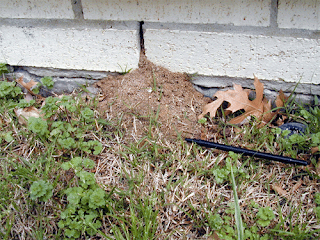 I've heard several pest management professionals say that they felt thresholds were not practical for their business. "We have a zero tolerance for pests," they typically say, "so thresholds just don't work for us." Health department standards are often cited as a justification for a zero threshold, as many health departments have no tolerance for cockroaches in a food handling establishment.
I've heard several pest management professionals say that they felt thresholds were not practical for their business. "We have a zero tolerance for pests," they typically say, "so thresholds just don't work for us." Health department standards are often cited as a justification for a zero threshold, as many health departments have no tolerance for cockroaches in a food handling establishment.Developed originally for agriculture, pest thresholds originally meant the level of pest presence on a crop where the damage caused by the pest equaled the cost of treatment (usually the cost of a pesticide application). This concept works well in situations where the cost of a single pest is relatively easily determined. It's much more difficult to establish thresholds where pests are simply a nuisance or where the exact health cost of an individual pest is difficult to define.
The problem of assessing pest damage in indoor environments is especially challenging. What is the cost to a restaurant of a single cockroach in a kitchen? Contrary to the myth that a single cockroach is sufficient to shut down a kitchen, health inspectors, in Texas at least, are charged to "[control pests] to minimize their presence within the physical facility and its contents, and on the contiguous land or property under the control of the permit holder..." Nevertheless, we all know that there are levels of pests that are clearly unacceptable.
Most people would agree that a single cockroach, or one mouse, entering a facility from a recently delivered box of food does not necessarily constitute an "infestation". And one or two cockroaches on a sticky card would likely justify a much different (and less costly) response than, say, 30 cockroaches found on several sticky cards. This is where thresholds can help both the pest control technician and the food establishment manager.
I believe the most useful kind of threshold for these settings is what I call the multiple response threshold, where thresholds are used to guide the appropriate response to escalating pest densities. A good technician understands this concept intuitively, whether he or she realizes it or not.
This week I helped conduct a class on IPM for school maintenance personnel. As part of the class we conducted a pest inspection of a school kitchen. The technician who serviced the school told me he had recently found two cockroaches in a particular area of the kitchen we were inspecting. I asked him what he did, and he said that he conducted a thorough inspection of the area and found no other signs of cockroaches. He did not apply a pesticide, but planned to keep a close eye on this area in the next few visits. When asked what he would have done had he found more cockroaches, he answered that he would have increased sanitation, brought in a vacuum and perhaps placed out some cockroach bait stations.
This is, in my opinion, the proper use of the IPM threshold concept for buildings.
But if a good technician knows this intuitively, then why is it necessary to have written thresholds? There are several reasons I can think of for written thresholds, especially for institutional accounts such schools, restaurants or hospitals: (1) Not all technicians are equally experienced, or understand what to do when they encounter different levels of pest problem; (2) not all institutions or businesses have the same tolerances for pests. If they have been previously reviewed and approved by the customer, written thresholds provide a way to ensure that the technician is familiar with the expectations of each account; (3) technicians rarely keep the same accounts for extended periods of time, so having written thresholds is an excellent training tool and way to standardize service among technicians; (4) the process of developing thresholds is a useful exercise in thinking through your IPM service strategy; and (5) thresholds can save time and expense, especially for institutions where pest control service is based on a work order system. It can be expensive to send technicians out on trivial pest control service calls, when more important calls await. In this case, thresholds can help a manager decide which work order requests deserve immediate response, and which are given lower priority.
If your company does not include written thresholds as part of its commercial IPM program, it may be time to reconsider. Besides being a good idea, having thoughtful and reasonable thresholds might just distinguish your company from competitors who also claim to be doing IPM.




